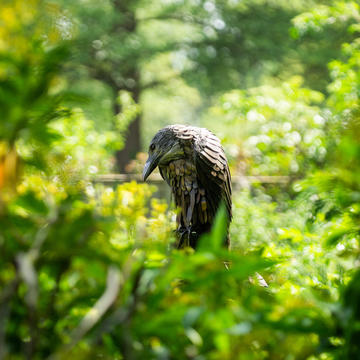The Lower Garden - Remake
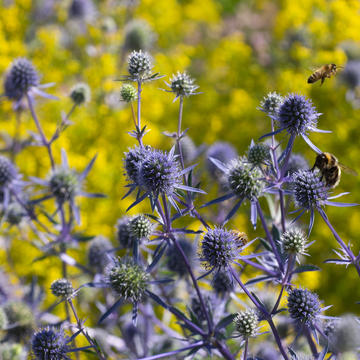
The Merton Borders
The Garden worked in collaboration with Professor James Hitchmough from the Department of Landscape Architecture at the University of Sheffield to develop the sustainable Merton Borders. The borders occupy an area of 955m2, and are an example of sustainable horticultural development, with the aim of having minimal impact on the environment in the long term.
The planting is based on an ecological study of natural plant communities to produce an ornamental yet sustainable display. 85% of the plants were established through the direct sowing of seed. This has two benefits: firstly, it is more sustainable than planting thousands of plants grown in peat-based composts and plastic containers. Secondly, sowing from seed makes it possible to establish plants at much higher densities. This increases the diversity of the plantings, and ensures a long succession of flowering through the season.
The plants have been selected for their ability to withstand drought conditions and originate from seasonally dry grassland communities in three regions of the world:
- The Central to Southern Great Plains (USA) through to the Colorado Plateau and into California
- East South Africa at altitudes above 1000m
- Southern Europe to Turkey, and across Asia to Siberia
Selecting plant species from these drier plant communities will build in a greater tolerance of warmer, drier summers.
The planting is colourful from spring to autumn, and represents a dynamic style of planting. It is also drought-tolerant, requiring no artificial irrigation, staking or fertilisers. It is allowed to die back over a long period after the autumn, providing a rich habitat for many types of small birds and mammals.
Plants that Changed the World & The Gin Border
Since 2015, this area – which was previously used to cultivate vegetables on the scale of an allotment – has been transformed into a showpiece collection highlighting plants that have changed the course of human civilisations across the globe. The plantings are a mixture of plants useful for food, medicines, fibres, dyes and much more, all illustrating how important plants are to our existence.
Botanicals used to flavour alcohol are grown in the adjoining Gin Border.
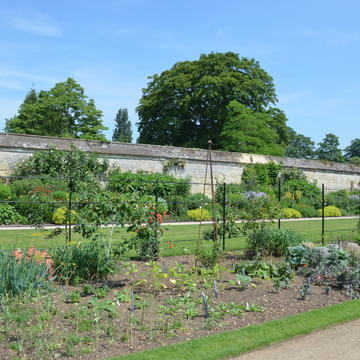
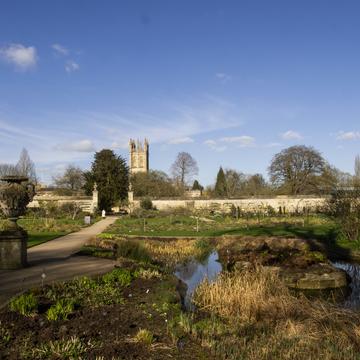
The Water Garden
The Water Garden is in the lowest-lying part of the Garden. Here we grow plants that require damper conditions to thrive.
It is managed less intensively, which provides a more naturalistic feel to the planting. A mixture of exotic and native species are grown. The native bog bean (Menyanthes trifoliata) can be seen growing in the water, whereas the large leaves of Gunnera from Brazil dominate the central island.
The majority of the plants are early flowering, so this area is at its most colourful in late spring, with the flowering of large stands of Iris sibirica, Darmera peltata and the native marsh marigold (Caltha palustris). Further interest is provided by the bold foliage of a number of marginal plants, including Rheum, Rodgersia, Ligularia and Hosta.
The inclusion of a pond not only increases the diversity of plants that can be grown in the Garden, but also increases the diversity of fauna. Dragonflies and newts can be seen here, as can nesting moorhens and coots.
The Herbaceous Border
First established in 1946, this planting is a classic example of the traditional English herbaceous border.
Unlike other areas of the Garden, it relies predominantly on herbaceous perennials. These die back to a rootstock each winter before bursting back into life again in spring and flowering through the summer.
The planting is designed to provide interest from April to October. The display begins with tulips in a range of colours, followed by early- to mid-season and late-flowering perennials. The plants are arranged in layers, with smaller plants positioned at the front of the border and taller plants towards the back. Occasionally, we allow a few of the larger plants to make their way to the front to break up the formality.
Key plants are repeated along the border to create a sense of continuity: peonies, lupins, phlox and asters, for example, which flower in succession throughout the season.
Traditional hand-woven staking is used to support the plants when in full growth. All of the material is cut annually from our sustainable coppice at the Arboretum.
Although the concept of this border is traditional, the plant selection is contemporary. By selecting new cultivars, we ensure the inclusion of plants that perform better for longer and are more resistant to pests and disease.
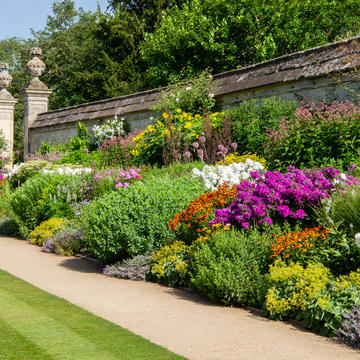
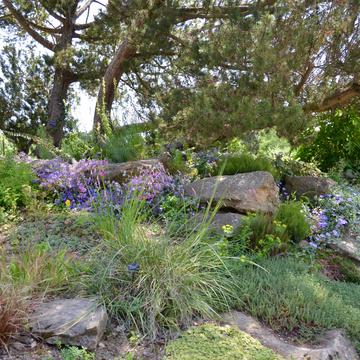
The Rock Garden
The Rock Garden was first constructed in 1926, and was later redesigned between November 2019 and June 2021 with support from the Martin Wills Trust. The 125 tonnes of sandstone were originally brought from a local quarry in Tubney, six miles west of Oxford and additional stone has been added from Purbeck in Dorset to create a small cliff face as part of recent renovations
The Rock Garden has recently undergone significant redesign to create a geographical plant display that illustrates former Director John Sibthorp’s 18th century journeys in the eastern Mediterranean which gave rise to the Flora Graeca, a very significant botanical work associated with Oxford Botanic Garden. The eastern side of the Rock Garden contains groupings of endemic plants from Greece, Turkey, Cyprus and Crete as well as from Israel. The western side of the Rock Garden is being developed to represent endemic flora from the western half of the Mediterranean including Sicily, Majorca and the Iberian peninsular.
In late winter, there is a fine display of snowdrops, followed by the flowering of species tulips in the spring and a mixture of Mediterranean annuals and perennials such as Cistus which give off their aromatic oils in this sunny, sheltered location. The dramatic Dracunculus vulgaris with its odorous dark purple flower spathes can be seen here in May.
The Autumn Borders
The Autumn Border runs the length of the Garden's boundary with Christ Church Meadow. The planting is designed to be at its peak in September and October, relying on strong colour contrasts of both foliage and flowers. Originally designed by Sandra and Nori Pope, the plantings have evolved over the years to include a wider range of plants.
Shrubs with colourful foliage, such as Cotinus coggygria ('Grace'), are used as a foil for late-flowering perennials and annuals. Tulips are planted in the autumn each year to provide spring interest. Then, in early June, the same areas are filled with tender perennials such as Dahlia, Canna and Salvia, and imposing annuals such as Ricinus communis and Tithonia rotundifolia.
Special pruning techniques are employed on shrubs to promote large foliage, and on perennials to produce an extended flowering display.
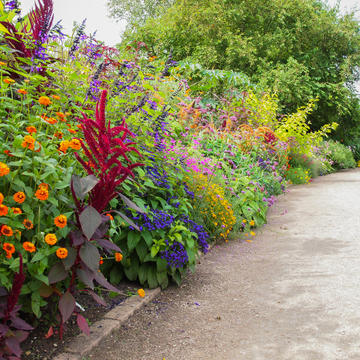
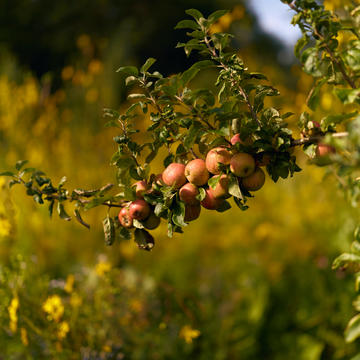
The Orchard
The Orchard contains 43 apple, pear and quince trees planted during the winters of 2011 and 2012 as one year old, bare-root trees.
The varieties were selected with the help of Chris Lanzack, a fruit expert at Waterperry Gardens in Oxfordshire. All have been chosen for their resistance to common pests and disease of top fruit, removing the need for the application of preventative pesticides and fungicides. The varieties have also been selected with the site in mind, ensuring we cultivate fruit trees that are likely to grow well in our soil and local environmental conditions.
The Orchard links with the Plants That Changed the World display, promoting sustainable development.
Dæmon Sculpture
Philip Pullman unveiled daemon sculpture in the Lower Garden on the 22 May 2019. The Oxford Botanic Garden was the setting for crucial scenes in his novel sequence His Dark Materials. The stainless steel sculpture is the work of sculptor Julian Warren and depicts the famous ‘daemons’ of this His Dark Materials. Situated behind the ‘Lyra and Will’s bench’ where the books’ principal characters enjoy a number of meetings.
This sculpture joins another in the Garden, the grinning Cheshire Cat of Lewis Carroll’s Alice in Wonderland, tucked away in the Literary Garden in the Walled Garden. The works are designed to stir people’s interest in horticulture through the medium of literature.
Read more about the unveiling in the Oxford Times.
